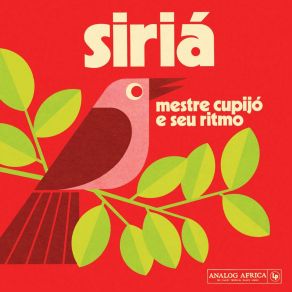Siriá / Siria
Download links and information about Siriá / Siria by Mestre Cupijó / Mestre Cupijo, Seu Ritmo. This album was released in 2014 and it belongs to World Music, Latin genres. It contains 14 tracks with total duration of 37:57 minutes.

|
|
|---|---|
| Artist: | Mestre Cupijó / Mestre Cupijo, Seu Ritmo |
| Release date: | 2014 |
| Genre: | World Music, Latin |
| Tracks: | 14 |
| Duration: | 37:57 |
| Buy it NOW at: | |
| Buy on iTunes $9.99 | |
| Buy on Amazon $8.99 | |
Tracks
[Edit]| No. | Title | Length |
|---|---|---|
| 1. | Mingau de Açai | 2:54 |
| 2. | Mambo do Martelo | 2:31 |
| 3. | Caboclinha do Igapo | 2:04 |
| 4. | Tubarao Branco | 2:13 |
| 5. | Morena do Rio Mutuaca | 2:53 |
| 6. | Papa Chibe | 2:53 |
| 7. | Farol do Marajo | 2:24 |
| 8. | Cadê o Anel | 2:45 |
| 9. | Ventinho do Norte | 3:46 |
| 10. | Siria Quente 2 | 3:08 |
| 11. | Eu Quero o Meu Anel | 2:50 |
| 12. | Perereca | 2:05 |
| 13. | Pra Dançar Meu Siria | 2:49 |
| 14. | Passarinho Siriri | 2:42 |
Details
[Edit]Analog Africa's mission to expose the hidden and unknown musics of Africa and South America has been globally recognized for its dedication to collecting, annotating, and tracing often blurry historical lineages and issuing finely curated recordings. Siriá by Mestre Cupijó e Seu Ritmo is an amazing case in point. The title refers to a style, an intense meld of roots music from the indigenous people of the Amazon rainforest and the quilomobos, residents of Cametá, a small town in the Northern Brazilian state of Pará, a settlement founded by escaped African slaves. Siriá's beats are relentless, a hybrid of many forms of Latin folk and African music. This set compiles work from six albums by the creator of siriá's modern form: Mestre Cupijó and his killer Seu Ritmo ensemble. Their music has for decades been the soundtrack for street parties and family celebrations across Northern Brazil. A multi-instrumentalist from the time he was a youngster, Cupijó mastered many musical forms: from boleros and cha chas to waltzes and danzons, but siriá and carimbó made the biggest impact on him. In order to learn to play these styles properly, he actually went to live among the quilomobos. Upon return, his life was changed. He dedicated himself to the creation of modern sounds firmly rooted in these musics. The 14 cuts here are in a variety of styles, from siriá to mambo to carimbó. A huge influence on these styles is cumbia and Samba de Cacente. One can hear it in the steamy "Morena do Rio Mutuaca," "Papa Chibé," and"Prá Dançá Meu Siriá," among other cuts. Horns play serpentine lyric lines, sometimes in call and response to a singer, or to create separate rhythmic patterns from frenetic layers of drums and electric guitars. The arrangements are designed to reflect the raw folk music at their core, while utilizing an expanded harmonic and percussive palette to push each root tune toward another. It is not a "fusion" sound, but a unique brew of its own. On opener "Mingau de Açai," one can hear not only cumbia, but no less than three separate African percussion parts, as Latin brass and reed lines support and challenge chanted vocals buoyed by a hypnotic bassline. On the mambo "Ventinho do Norte," one can hear other Caribbean sounds such as bluebeat ska, son, and even Latin jazz woven through its intense pulse. The pronounced guitar on "Farol do Marajó" (the lone carimbó here) is offset by a narrative, sweet vocal and punchy horns between verses, as a hand cymbal guides the beat. That guitar is even more pronounced as the driving rhythmic vehicle for choppy horns (with beautiful trombone fills), a thrumming bassline, and counterpoint percussion. Mestre Cupijó's Siriá is the encounter of rural life meeting the city, with both transformed by it. It is a music of great discipline that expresses joy and freedom abundantly.